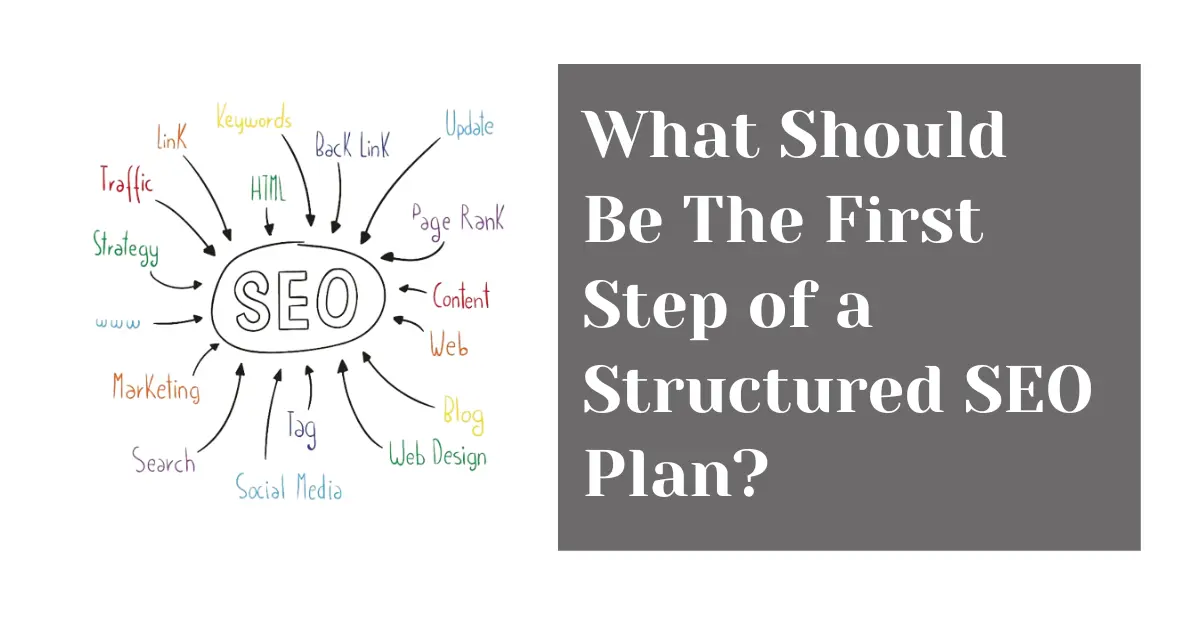In the ever-evolving landscape of digital marketing, having a well-structured SEO plan is crucial for businesses aiming to enhance their online visibility. A structured SEO plan not only helps in achieving higher search engine rankings but also ensures long-term sustainability. If you’re wondering where to begin, the first step is crucial and sets the tone for the entire SEO strategy.
Table of Contents
In the vast realm of digital marketing, Search Engine Optimization (SEO) stands out as a cornerstone for businesses striving to establish a robust online presence. The dynamics of SEO have evolved, making it imperative for organizations to adopt a structured approach.
This article aims to unravel the mysteries of initiating a well-organized SEO plan, focusing on the pivotal first step.
Understanding Business Goals
Before delving into the intricacies of SEO, it’s paramount to have a clear understanding of your business goals. Aligning SEO objectives with overarching business goals ensures a coherent strategy. Whether it’s increasing online sales, brand visibility, or lead generation, defining these goals sets the foundation for a purposeful SEO plan.
Keyword Research
A cornerstone of any effective SEO strategy is comprehensive keyword research. Identifying the right keywords relevant to your business is akin to unlocking the door to increased organic traffic. Utilize tools like Google Keyword Planner and SEMrush to unearth valuable keywords that resonate with your target audience.
Keyword research is the process of identifying and analyzing the relevant search terms that people use to find information online. It’s a crucial step in search engine optimization (SEO) and content marketing as it helps you understand your target audience’s search behavior and tailor your content to match their intent.

Why is keyword research important?
Keyword research offers several benefits for your online presence:
- Traffic Generation: By targeting relevant keywords, you can attract more qualified visitors to your website, increasing your chances of conversions and sales.
- Content Optimization: Keyword research guides your content creation strategy, ensuring you produce content that aligns with your audience’s search queries and addresses their needs.
- Improved Search Rankings: Targeting relevant keywords with high search volume can improve your website’s visibility in search engine results pages (SERPs), leading to better organic rankings.
- Effective PPC Campaigns: Keyword research is essential for creating effective pay-per-click (PPC) advertising campaigns. By selecting relevant keywords, you can ensure your ads are displayed to the right audience, optimizing your ad spend.
How to conduct keyword research?
There are several steps involved in conducting effective keyword research:
- Brainstorm Seed Keywords: Start by brainstorming a list of broad keywords related to your website’s topic or products. These seed keywords will serve as the basis for your research.
- Use Keyword Research Tools: Leverage keyword research tools like Google Keyword Planner, SEMrush, or Ahrefs to gather data on keyword search volume, competition, and related keywords.
- Analyze Keyword Intent: Understand the intent behind each keyword. Are users searching for information, comparing products, or ready to buy? Align your content with the search intent to provide the right information at the right time.
- Consider Long-Tail Keywords: Focus on long-tail keywords, which are more specific and less competitive, to target a more niche audience and improve your chances of ranking for those terms.
- Evaluate Keyword Difficulty: Assess the difficulty of ranking for each keyword. While high-volume keywords may bring more traffic, they can also be more challenging to rank for.
- Balance Keyword Relevance and Difficulty: Prioritize keywords that are relevant to your content and have a manageable difficulty level, ensuring you attract the right audience without facing excessive competition.
Keyword research tools:
Here are some popular keyword research tools:
- Google Keyword Planner: A free tool from Google that provides keyword search volume data and suggestions.
- SEMrush: A comprehensive tool that offers keyword research, competitor analysis, and backlink tracking.
- Ahrefs: Another powerful tool with a focus on keyword research, site audits, and competitor analysis.
- Moz Keyword Explorer: A user-friendly tool that provides keyword research, SERP analysis, and keyword difficulty scores.
- Ubersuggest: A freemium tool with keyword research, content planning, and competitor analysis features.
Remember, keyword research is an ongoing process that should be revisited regularly to adapt to changing search trends and user behavior. By conducting thorough keyword research, you can create a strategic content plan for a structured SEO plan that attracts the right audience, drives traffic, and enhances your online presence.
Competitor Analysis
Analyzing competitors provides valuable insights into successful strategies and areas for improvement. Identify competitors in your niche, evaluate their strengths and weaknesses, and leverage this information for strategic advantage.
Competitor analysis is the process of identifying, evaluating, and understanding your competitors’ strengths, weaknesses, products, services, marketing strategies, and overall business strategies. It’s a crucial aspect of business planning, marketing, and overall business success.

Why is competitor analysis important?
Competitor analysis offers several benefits for your business:
- Identify Industry Trends: By understanding your competitors’ actions, you can gain insights into emerging trends and market shifts, allowing you to adapt and innovate accordingly.
- Assess Strengths and Weaknesses: Analyzing your competitors’ strengths and weaknesses helps you identify areas where you excel and areas where you need to improve.
- Develop Competitive Advantage: By understanding your competitors’ strategies and offerings, you can differentiate your business and develop a unique selling proposition (USP) that sets you apart.
- Inform Marketing Strategies: Competitor analysis guides your marketing strategy, ensuring you target the right audience, use effective messaging, and optimize your pricing and positioning.
- Benchmark Performance: Comparing your performance to your competitors helps you track your progress, identify areas for improvement, and set realistic goals.
How to conduct competitor analysis:
There are several steps involved in conducting effective competitor analysis:
- Identify Your Competitors: Determine who your direct and indirect competitors are. Direct competitors offer similar products or services to the same target audience, while indirect competitors satisfy the same need but may offer different products or target different segments.
- Gather Information: Collect information about your competitors’ products, services, pricing, marketing strategies, website traffic, social media presence, customer reviews, and financial performance.
- Analyze Strengths and Weaknesses: Identify each competitor’s strengths and weaknesses. Strengths may include brand recognition, market share, unique product features, or effective marketing campaigns. Weaknesses may include outdated technology, poor customer service, or limited product offerings.
- Evaluate Competitive Strategies: Analyze your competitors’ marketing strategies, pricing strategies, distribution channels, and customer engagement approaches.
- Identify Opportunities and Threats: Identify opportunities to capitalize on your competitors’ weaknesses or gaps in the market. Also, identify potential threats posed by your competitors, such as new product launches or aggressive marketing campaigns.
- Document Findings: Organize and document your findings in a clear and concise manner. This will serve as a valuable reference for your team and inform future business decisions.
Competitor analysis tools:
Several tools can aid in competitor analysis:
- Google Alerts: Set up Google Alerts to track mentions of your competitors and relevant industry keywords.
- Social Mention: Monitor your competitors’ social media presence and track mentions of their brand.
- BuzzSumo: Analyze the most shared and popular content from your competitors and industry leaders.
- SEMrush: Analyze your competitors’ website traffic, keyword rankings, and backlinks.
- SimilarWeb: Compare your website traffic and engagement metrics to those of your competitors.
Remember, competitor analysis is an ongoing process that should be revisited regularly to stay up-to-date with your competitors’ activities and adapt your business strategies accordingly. By conducting thorough competitor analysis, you can gain valuable insights, make informed decisions, and position your business for success in a competitive market.
On-Page Optimization
Optimizing your website’s on-page elements is a fundamental step in SEO. From crafting compelling meta tags to optimizing headers and content, on-page optimization enhances your site’s visibility to search engines.

On-page optimization (also known as on-site SEO) is the process of optimizing various front-end and back-end components of your website to improve its search engine rankings and earn organic traffic. It involves optimizing various elements of your website, including:
- Content: Create high-quality, informative, and relevant content that aligns with your target audience’s search intent.
- Title Tags: Craft clear, concise, and keyword-rich title tags that accurately describe the content of each page.
- Meta Descriptions: Write engaging and informative meta descriptions that provide a brief overview of each page’s content.
- Header Tags (H1, H2, H3): Use appropriate header tags to structure your content and highlight the most important sections.
- Image Optimization: Optimize images with relevant filenames, alt tags, and image compression to improve page loading speed and accessibility.
- Internal Linking: Create a well-structured internal linking system to guide users and distribute link equity within your website.
- URL Structure: Keep URLs clean, concise, and descriptive, using relevant keywords and a clear hierarchy.
- Mobile-friendliness: Ensure your website is mobile-friendly and responsive, providing a seamless user experience across devices.
- Page Loading Speed: Optimize your website’s loading speed to enhance user experience and meet search engine ranking factors.
- Technical SEO: Address technical aspects like sitemaps, robots.txt, and schema markup to improve crawlability and search engine understanding.
Remember, on-page optimization is an ongoing process that requires regular attention and updates to maintain your website’s relevance and search engine visibility. By implementing these on-page optimization strategies, you can improve your website’s search engine rankings, attract more organic traffic, and achieve your business goals.
Technical SEO
Addressing technical aspects ensures search engine compatibility. Evaluate site speed, mobile responsiveness, and crawlability to provide a seamless experience for both users and search engines.
Technical SEO plays a crucial role in a structured SEO plan as it ensures that search engines can easily crawl, index, and understand your website. By addressing technical SEO aspects, you can enhance your website’s visibility and improve its chances of ranking well in search results.

Essential Technical SEO Elements for a Structured SEO Plan:
- Website Crawlability: Ensure your website is easily crawlable by search engines by optimizing your sitemap, robots.txt file, and URL structure.
- Mobile-friendliness: Make your website mobile-friendly and responsive to provide a seamless user experience across all devices.
- Page Loading Speed: Optimize page loading speed by minimizing redirects, compressing images, and leveraging caching mechanisms.
- Structured Data Markup: Implement structured data markup to provide search engines with rich information about your content, enhancing search results snippets.
- Canonical URLs: Use canonical URLs to indicate the preferred version of a page, preventing duplicate content issues.
- HTTPS Security: Implement SSL/TLS encryption to secure your website and demonstrate trustworthiness to search engines.
- Website Architecture: Create a clear and logical website architecture that allows search engines to efficiently navigate your site.
- URL Structure: Keep URLs clean, concise, and descriptive, using relevant keywords and a clear hierarchy.
- Error Handling: Implement proper error handling mechanisms to handle 404 errors, redirecting users to relevant pages.
- Sitemap Submission: Submit your website’s sitemap to search engines to improve their understanding of your site structure.
- robots.txt File: Utilize the robots.txt file to guide search engine bots and prevent them from crawling restricted areas.
- URL Parameters: Manage URL parameters effectively to avoid indexation issues and ensure search engines understand the content.
- Pagination: Implement proper pagination techniques to prevent indexation issues and ensure search engines discover all paginated content.
- JavaScript Rendering: Ensure your website’s content is rendered correctly by search engines, even if it relies on JavaScript.
- Log File Analysis: Regularly monitor server logs to identify and address potential technical issues that may impact SEO.
By addressing these technical SEO elements, you can create a solid foundation for your structured SEO plan, ensuring that your website is technically sound and search engine friendly.
Quality Content Creation
Content is king in the digital realm. Create high-quality, relevant, and engaging content that not only caters to your audience but also aligns with search engine algorithms, boosting your site’s rankings.
Quality content creation is the cornerstone of a successful structured SEO plan. By consistently producing high-quality, informative, and engaging content, you can attract and retain a loyal audience, establish your website as a thought leader in your industry, and ultimately boost your search engine rankings.

Key Characteristics of Quality Content for SEO:
- Relevance: Content should align with your target audience’s interests and search intent, addressing their needs and providing solutions to their problems.
- Uniqueness and Originality: Offer fresh perspectives, insightful analysis, and unique content that stands out from the competition.
- Depth and Comprehensiveness: Provide in-depth coverage of topics, exploring various angles and offering valuable insights.
- Accuracy and Credibility: Ensure content is factually accurate, well-researched, and backed by credible sources.
- Engaging and Readable: Write in a clear, concise, and engaging style that captivates readers and keeps them coming back for more.
- Visually Appealing: Incorporate high-quality images, infographics, and videos to enhance content and improve visual appeal.
- Optimized for Search Engines: Strategically incorporate relevant keywords throughout your content, but avoid keyword stuffing.
- Regular Publication: Maintain a consistent content creation schedule to keep your audience engaged and search engines updated.
Effective Content Creation Strategies for SEO:
- Identify Target Audience: Understand your target audience’s demographics, interests, and search behavior to tailor content accordingly.
- Keyword Research: Conduct thorough keyword research to identify relevant search terms that align with your target audience’s intent.
- Content Ideation: Brainstorm content ideas that address your target audience’s needs, answer their questions, and provide value.
- Content Planning: Develop a content calendar to plan and schedule content creation, ensuring consistency and focus.
- Content Creation Process: Establish a workflow for creating content, including research, writing, editing, and proofreading.
- Content Optimization: Optimize content for search engines using relevant keywords, meta descriptions, and internal linking.
- Content Promotion: Promote your content through social media, email marketing, and influencer outreach.
- Content Analytics: Track content performance metrics, such as traffic, engagement, and conversions, to identify what resonates with your audience.
Content Creation Tools and Resources:
- Content Management Systems (CMS): Utilize CMS platforms like WordPress or Drupal to manage your website’s content efficiently.
- Grammar and Writing Tools: Use grammar checkers like Grammarly or Hemingway Editor to ensure clear and concise writing.
- Plagiarism Checkers: Utilize plagiarism checkers like Turnitin or Copyscape to ensure originality and avoid copyright issues.
- Image Editing Software: Leverage image editing tools like Adobe Photoshop or Canva to create high-quality visuals.
- Content Analytics Tools: Use analytics tools like Google Analytics or Parsely to track content performance and identify areas for improvement.
- SEO Writing Guides and Resources: Refer to SEO writing guides and resources, such as Moz or SEMrush, to stay updated on best practices.
By investing in quality content creation and implementing effective strategies, you can establish your website as a valuable resource, attract organic traffic, and achieve your SEO goals.
Remember, content is the heart of a successful SEO strategy, and consistently delivering high-quality content will set you apart in the competitive digital landscape.
Link Building [Backlink] Strategies
Building a robust backlink profile is crucial for SEO success. Focus on white-hat link building techniques to establish credibility and authority in your industry.
Link building is an integral part of a structured SEO plan as it helps establish your website’s authority and credibility in the eyes of search engines. By acquiring high-quality backlinks from reputable sources, you can boost your website’s search rankings and attract more organic traffic.

Essential Link Building Strategies for a Structured SEO Plan:
- Create High-Quality Content: Produce valuable, informative, and engaging content that attracts natural backlinks from other websites.
- Guest Blogging: Contribute guest posts to relevant and high-authority websites in your niche to gain backlinks and reach a wider audience.
- Broken Link Building: Identify and reach out to website owners who have broken links, offering to replace their broken links with your relevant and informative content.
- Resource Page Link Building: Find resource pages in your industry and reach out to website owners to suggest including your relevant and valuable content as a resource.
- Social Media Outreach: Actively engage on social media, share your content, and build relationships with influencers in your niche to attract backlinks.
- Industry Awards and Recognition: Apply for relevant industry awards and recognition programs to gain backlinks and establish your website’s expertise.
- Infographic and Visual Content: Create high-quality infographics, visual content, and data-driven pieces that are likely to be shared and attract backlinks.
- Press Releases and Media Outreach: Issue newsworthy press releases and reach out to relevant media outlets to generate backlinks and brand awareness.
- Internal Linking: Implement a strong internal linking strategy to pass link equity between your website’s pages and boost the authority of important pages.
- Link Reclamation: Check for unlinked mentions of your brand or website and reach out to the website owners to request a backlink.
- Link Monitoring and Analysis: Regularly monitor your backlink profile using SEO tools to identify and address any potential problems with your backlinks.
- Link Quality: Focus on acquiring high-quality backlinks from relevant and reputable websites rather than focusing on quantity alone.
- Link Diversity: Acquire backlinks from a variety of sources, including blogs, news websites, industry directories, and social media platforms.
- Link Velocity: Build backlinks gradually over time, avoiding unnatural spikes in backlink acquisition that may raise red flags for search engines.
- Link Removal: Remove or disavow any low-quality or spammy backlinks that may harm your website’s reputation.
By implementing these link building strategies, you can effectively enhance your website’s backlink profile, improve its search engine authority, and achieve your SEO goals.
Local SEO
For businesses with a local presence, optimizing for local search is imperative. Claim and optimize your Google My Business listing and ensure consistent local citations across online directories.
Local SEO is a crucial aspect of a structured SEO plan for businesses that target a specific geographic location. By optimizing your website and online presence for local search, you can increase your visibility and attract customers from your local area.

Essential Local SEO Strategies for a Structured SEO Plan:
- Google My Business Profile: Create and optimize your Google My Business (GMB) profile to ensure it appears prominently in local search results. Include accurate and up-to-date information about your business, such as name, address, phone number (NAP), hours of operation, website, and business description.
- Local Citations: Build a strong presence across local directories and citation websites, ensuring your business NAP is consistent across all platforms. Use tools like BrightLocal or Moz Local to identify and manage local citations.
- Local Content Creation: Create high-quality, locally relevant content, such as blog posts, articles, or infographics, that targets local keywords and topics of interest to your target audience.
- Local Reviews and Reputation Management: Encourage customers to leave positive reviews on Google My Business and other relevant review sites. Actively manage your online reputation by responding to reviews, both positive and negative.
- Local Link Building: Acquire backlinks from local websites, such as local news sites, chambers of commerce, or community organizations, to boost your local search authority.
- Local SEO Tools and Resources: Utilize local SEO tools and resources, such as Google Search Console, Moz Local, or BrightLocal, to track your progress, monitor local search rankings, and identify areas for improvement.
- Local Events and Engagement: Participate in local events, sponsor local organizations, and engage with your local community to increase brand awareness and local recognition.
- Local Schema Markup: Implement local schema markup on your website to provide search engines with rich information about your business, such as location, phone number, and hours of operation.
- Mobile-friendliness: Ensure your website is mobile-friendly and provides a seamless user experience for local searchers using mobile devices.
- Local Search Insights: Analyze local search data using tools like Google Search Console or Google Trends to identify popular local keywords and search queries relevant to your business.
Monitoring and Analytics
Implement tools like Google Analytics to monitor your SEO performance. Analyze data regularly to identify trends, track key metrics, and make informed decisions for ongoing optimization.
Monitoring and analytics are crucial components of a structured SEO plan, as they provide valuable insights into your website’s performance and help you identify areas for improvement. By regularly tracking key metrics and analyzing data, you can make informed decisions to optimize your SEO strategies and achieve your desired results.

Essential Monitoring and Analytics Tools for a Structured SEO Plan:
- Google Analytics: Google Analytics is a powerful tool that provides comprehensive website traffic data, including visitor demographics, referral sources, page views, and bounce rates.
- Google Search Console: Google Search Console offers insights into your website’s search engine rankings, crawl errors, and keyword performance.
- Rank Tracking Tools: Rank tracking tools like Semrush or Ahrefs allow you to monitor your website’s rankings for specific keywords over time.
- Social Media Analytics: Social media analytics tools provide insights into your social media engagement, audience demographics, and campaign performance.
Key Metrics to Monitor for a Structured SEO Plan:
- Organic Traffic: Track the amount of organic traffic coming to your website from search engines.
- Keyword Rankings: Monitor your website’s rankings for targeted keywords to assess SEO performance.
- Conversion Rate: Track the percentage of visitors who take a desired action, such as making a purchase or signing up for a newsletter.
- Bounce Rate: Measure the percentage of visitors who leave your website after viewing only one page.
- Average Session Duration: Track the average amount of time visitors spend on your website.
- Backlink Profile: Monitor your website’s backlink profile to assess link quality and authority.
- Social Media Engagement: Track metrics like likes, shares, and comments to measure social media engagement.
- Brand Mentions: Monitor mentions of your brand across social media and online platforms to gauge brand awareness.
Frequency of Monitoring and Analysis:
- Daily: Check daily traffic and keyword rankings for immediate insights and identify any potential issues.
- Weekly: Conduct a more in-depth analysis of website traffic, conversions, and social media engagement.
- Monthly: Review overall SEO performance trends, identify areas for improvement, and set new goals.
- Quarterly: Conduct a comprehensive SEO audit to assess the effectiveness of your strategies and make necessary adjustments.
Actionable Insights from Monitoring and Analysis:
- Identify top-performing and underperforming pages: Optimize underperforming pages based on insights from analytics.
- Refine keyword strategy: Adjust keyword targets based on ranking performance and search trends.
- Improve content quality and relevance: Enhance content based on user engagement and search intent data.
- Address technical SEO issues: Resolve crawl errors, improve page loading speed, and enhance mobile-friendliness.
- Optimize website for local search: Target local keywords and build local citations to improve local visibility.
- Enhance social media presence: Create engaging content, interact with followers, and run targeted social media campaigns.
- Monitor competitor activity: Analyze competitor strategies and identify opportunities to outperform them.
- Track ROI of SEO efforts: Measure the return on investment of your SEO initiatives and make data-driven decisions.
By effectively monitoring and analyzing your website’s performance, you can gain valuable insights, optimize your SEO strategies, and achieve your desired results in terms of website traffic, engagement, and conversions.
Adapting to Algorithm Changes
Adapting to algorithm changes is an ongoing process for any website that wants to maintain its visibility and ranking in search engine results pages (SERPs). Search engines like Google continuously update their algorithms to provide users with the most relevant and accurate results, and these changes can significantly impact your website’s performance.

Key Steps to Adapting to Algorithm Changes:
- Stay Informed: Keep up-to-date with the latest algorithm changes by following industry news, blogs, and forums. Utilize tools like Google Search Console and Moz to receive notifications and alerts about algorithm updates.
- Analyze Impact: Assess the impact of algorithm changes on your website’s traffic, rankings, and conversions. Use analytics tools to track changes in key metrics and identify areas that may require attention.
- Review Content Quality: Ensure your website’s content is high-quality, informative, and relevant to your target audience. Regularly review and update existing content, and create fresh content that addresses current search trends and user intent.
- Technical SEO Optimization: Maintain a technically sound website that is easy for search engines to crawl and index. Address any technical issues, such as page loading speed, mobile-friendliness, and structured data markup.
- Backlink Profile Review: Monitor your website’s backlink profile, ensuring the quality and relevance of your backlinks. Remove low-quality or spammy backlinks that may negatively impact your website’s reputation.
- User Experience Enhancement: Focus on enhancing the overall user experience of your website. Ensure easy navigation, clear design, and a seamless user journey to provide a positive user experience.
- Data-Driven Decisions: Make data-driven decisions based on analytics and insights gained from various sources. Use data to identify areas for improvement, prioritize strategies, and track progress over time.
- Continuous Monitoring: Continuously monitor your website’s performance and adapt your SEO strategies accordingly. Algorithm changes are an ongoing process, so regular monitoring and adaptation are crucial for long-term success.
- Seek Expert Guidance: Consider consulting with SEO experts or agencies for specialized guidance and assistance in adapting to algorithm changes. Their expertise can help you navigate complex SEO issues and optimize your strategies effectively.
Remember, adapting to algorithm changes is not a one-time task; it’s an ongoing process that requires continuous monitoring, analysis, and adaptation. By staying informed, focusing on quality content, and prioritizing user experience, you can effectively navigate algorithm changes and maintain your website’s visibility in search results.
Search engine algorithms are dynamic and subject to frequent changes. Stay informed about updates and adapt your SEO strategy accordingly to stay ahead of the curve.
User Experience and SEO
User experience directly impacts SEO rankings. Enhance site usability, improve page load times, and create a seamless browsing experience for visitors.
Social Media Integration
Leverage the power of social media to complement your SEO efforts. Social signals contribute to search engine rankings, making a strong social media presence beneficial for SEO.
Social media integration plays a crucial role in a structured SEO plan as it helps amplify your website’s reach, enhance brand awareness, and drive traffic back to your site. By strategically incorporating social media into your SEO efforts, you can effectively boost your online presence and achieve your overall SEO goals.

Key Advantages of Social Media Integration for SEO:
- Increased Brand Awareness: Social media platforms provide a powerful channel to promote your brand, engage with potential customers, and establish a strong online presence.
- Content Amplification: Sharing your website’s content on social media expands its reach, attracting new visitors and increasing overall traffic.
- Social Signals: Social media engagement metrics, such as likes, shares, and comments, can positively influence search engine rankings.
- Community Building: Social media fosters interactions with your target audience, building relationships and loyalty.
- Customer Engagement: Social media allows you to address customer queries, resolve issues, and provide excellent customer service.
Social Media Integration Strategies for SEO:
- Content Sharing: Share high-quality, relevant content from your website on social media platforms, using visually appealing formats and engaging captions.
- Social Media Scheduling: Utilize social media scheduling tools to plan and automate content publishing, ensuring consistent social media presence.
- Targeted Audience Engagement: Identify your target audience on social media platforms and tailor your content and interactions accordingly.
- Social Media Contests and Giveaways: Host social media contests and giveaways to generate excitement, attract new followers, and drive traffic to your website.
- Social Media Monitoring: Monitor social media conversations about your brand, industry, and competitors to gain valuable insights and respond promptly.
- Social Media Analytics: Regularly analyze social media data to track engagement metrics, identify top-performing content, and measure the effectiveness of your social media efforts.
- Integrate Social Media with Website: Integrate social media buttons and feeds into your website to encourage visitors to connect with your brand on social media platforms.
- Encourage Social Sharing: Add social sharing buttons to your website’s content, making it easy for visitors to share your articles, blog posts, or infographics on their social media channels.
- Leverage Social Media Advertising: Utilize social media advertising platforms to target specific demographics and interests, driving traffic to your website and promoting your content.
- Social Media Influencers: Collaborate with relevant social media influencers to reach a wider audience, enhance brand credibility, and gain exposure to a new follower base.
By incorporating these social media integration strategies into your structured SEO plan, you can effectively leverage the power of social media to enhance your website’s visibility, boost traffic, and achieve your SEO objectives. Social media, when combined with a comprehensive SEO strategy, can significantly amplify your online presence and drive meaningful results for your business.
Mobile SEO Optimization
With the prevalence of mobile search, optimizing your site for mobile devices is non-negotiable. Ensure mobile responsiveness and a user-friendly experience for mobile users.
Mobile SEO optimization is an essential component of a structured SEO plan in today’s mobile-first world. By ensuring your website is optimized for mobile devices, you can provide a seamless user experience for mobile visitors, enhance your website’s search engine rankings, and attract more mobile traffic.

Essential Mobile SEO Optimization Strategies for a Structured SEO Plan:
- Mobile-Friendly Design: Implement a responsive design that adapts your website’s layout and content to different screen sizes and devices.
- Page Loading Speed: Optimize page loading speed for mobile devices, minimizing redirects, compressing images, and leveraging caching mechanisms.
- Easy Navigation: Ensure easy navigation on mobile devices, using large tap targets, clear menus, and intuitive navigation structures.
- Font Size and Readability: Use appropriate font sizes and line heights for mobile devices to enhance readability and prevent eye strain.
- Touch-Friendly Taps and Swipes: Optimize interactive elements for touch-based interactions, ensuring easy tapping, swiping, and scrolling.
- Mobile-Specific Content: Create mobile-specific content, such as shorter paragraphs, bullet points, and infographics, tailored for mobile consumption.
- Mobile Search Intent: Align your mobile content with mobile search intent, focusing on providing quick answers and immediate solutions for mobile users.
- Structured Data Markup for Mobile: Implement structured data markup specifically for mobile devices, providing rich information to search engines.
- Mobile-First Indexing: Prepare your website for mobile-first indexing, ensuring your mobile content is crawlable and discoverable by search engines.
- Mobile User Testing: Regularly conduct mobile user testing to identify and address any usability issues on mobile devices.
Mobile SEO Optimization Tools and Resources:
- Google’s Mobile-Friendly Test: Check your website’s mobile-friendliness using Google’s Mobile-Friendly Test tool.
- PageSpeed Insights: Analyze your website’s page loading speed for mobile devices using Google’s PageSpeed Insights tool.
- Mobile SEO Tools: Utilize mobile SEO tools like Semrush or Ahrefs to track your website’s mobile rankings and identify areas for improvement.
- Mobile Testing Platforms: Use mobile testing platforms like BrowserStack or TestRail to test your website’s functionality and usability across different mobile devices.
Monitoring and Analysis for Mobile SEO:
- Mobile Traffic Data: Track mobile traffic volume and engagement metrics using Google Analytics and other analytics tools.
- Mobile Search Rankings: Monitor your website’s rankings for mobile-specific keywords using rank tracking tools.
- Mobile User Feedback: Gather feedback from mobile users through surveys, polls, or social media interactions to identify areas for improvement.
- Mobile Conversion Rates: Track conversion rates for mobile visitors to assess the effectiveness of your mobile SEO efforts.
- Mobile SEO Audits: Conduct regular mobile SEO audits to identify and address any technical or usability issues that may hinder mobile performance.
By implementing these mobile SEO optimization strategies and utilizing the available tools and resources, you can effectively optimize your website for mobile devices, enhance your mobile search engine rankings, and attract more mobile traffic, driving success in today’s mobile-centric digital landscape.
Which of the following would be an ideal goal for an SEO plan?
An ideal goal for an SEO plan would be to increase organic website traffic from relevant search engine results pages (SERPs). This means attracting more visitors to your website who are actively searching for information or products related to your business or brand.
Here are some specific examples of ideal SEO goals:
- Increase website traffic from targeted keywords: This means ranking higher for relevant keywords that people are searching for. For example, if you are a shoe retailer, you might want to increase your website traffic for keywords like “women’s running shoes” or “men’s hiking boots.”
- Improve organic conversion rate: This means turning more website visitors into customers or leads. For example, you might want to increase your email sign-ups or online sales.
- Enhance brand awareness: This means making your brand more visible and recognizable online. For example, you might want to increase your website traffic from branded keywords (your brand name) and non-branded keywords (keywords related to your products or services).
It is important to note that SEO goals should be SMART (Specific, Measurable, Achievable, Relevant, and Time-bound). This will help you to track your progress and ensure that your SEO plan is effective.
Here are some examples of SMART SEO goals:
- Increase website traffic from targeted keywords by 20% in the next six months.
- Improve organic conversion rate by 10% in the next quarter.
- Increase branded keyword traffic by 15% in the next year.
By setting SMART SEO goals, you can create a plan that will help you achieve your desired results.
Conclusion
In conclusion, a structured SEO plan is the key to unlocking digital success. By understanding business goals, conducting thorough research, and implementing best practices, businesses can navigate the competitive landscape and achieve sustainable online growth.
FAQs
How often should I update my SEO strategy?
The frequency with which you should update your SEO strategy depends on several factors, including the size and complexity of your website, the competitiveness of your industry, and the frequency of changes to search engine algorithms. However, a good rule of thumb is to review and update your SEO strategy at least once a quarter.
Regular updates are recommended, especially in response to algorithm changes or shifts in business goals.
Here are some specific reasons why you should update your SEO strategy regularly:
Search engine algorithms are constantly changing. Google, for example, makes hundreds of changes to its algorithm each year. This means that your SEO strategy may need to be updated to keep up with the latest changes.
Your website’s content and structure may change. As you add new pages or blog posts, or make changes to your website’s design, you may need to update your SEO strategy accordingly.
Your competitors’ SEO strategies may change. It’s important to keep an eye on what your competitors are doing and make sure that your SEO strategy is still competitive.
Your target audience’s needs and interests may change. Over time, your target audience’s needs and interests may change. This means that you may need to update your SEO strategy to make sure that you are still reaching the right people with the right content.
Here are some tips for updating your SEO strategy:
Review your website’s traffic and rankings. Use tools like Google Analytics and Google Search Console to track your website’s traffic and rankings. This will help you identify any areas where your SEO strategy is not working effectively.
Analyze your website’s backlinks. Use tools like Ahrefs or Semrush to analyze your website’s backlinks. This will help you identify any opportunities to build new backlinks or improve the quality of your existing backlinks.
Research your keywords. Use keyword research tools like Google Keyword Planner or SEMrush to research new keywords and identify opportunities to improve your keyword targeting.
Review your website’s content. Make sure that your website’s content is still relevant and up-to-date. You may also want to consider adding new content to your website.
Update your website’s technical SEO. Make sure that your website is technically sound and that it is easy for search engines to crawl and index.
By following these tips, you can ensure that your SEO strategy is always up-to-date and that you are getting the most out of your SEO efforts.
Is local SEO essential for businesses operating globally?
Local SEO can still be beneficial for businesses operating globally, even if they have a physical presence in multiple locations or serve a global audience. Here are some reasons why local SEO is still important for global businesses:
While global visibility is crucial, optimizing for local search enhances relevance and trust within specific markets.
- Local Searches: Even people who are searching for information globally will often use local search terms, such as “best restaurants near me” or “hair salons in [city name].” Local SEO can help your business appear in these results, even if you have a global presence.
- Targeted Marketing: Local SEO allows you to target your marketing efforts to specific locations. This can be helpful for reaching customers in areas where you have a strong physical presence or where you want to expand your reach.
- Brand Reputation: Local SEO can help you manage your brand reputation in specific locations. This is important for businesses that have multiple locations, as negative reviews can damage your reputation in a particular area.
- Customer Engagement: Local SEO can help you engage with customers in specific locations. This can be done through social media, local events, and other forms of community outreach.
- Voice Search: Voice search is becoming increasingly popular, and local SEO can help your business appear in voice search results. This is especially important for businesses that have a physical presence in multiple locations.
Here are some tips for implementing local SEO for businesses operating globally:
- Create local landing pages: Create separate landing pages for each of your locations. These landing pages should include your location information, business hours, and contact information.
- Optimize your website for local search: Use local keywords throughout your website, including in your title tags, meta descriptions, and content.
- Build local backlinks: Get backlinks from local websites and directories.
- Manage your online reviews: Respond to all reviews, both positive and negative.
- Get involved in the local community: Participate in local events and sponsor local organizations.
- Use social media to connect with local customers: Share local news and events and respond to comments and questions from local customers.
- Use local schema markup: Implement local schema markup to help search engines understand your location information.
By following these tips, you can make sure that your global business is also visible in local search results.
What role does social media play in SEO?
Social media plays a significant role in SEO, influencing both website traffic and search engine rankings. While social media signals are not direct ranking factors, they can indirectly impact SEO performance by driving traffic, building brand awareness, and enhancing user engagement.
Key Benefits of Social Media for SEO:
- Increased Website Traffic: Social media platforms provide a powerful channel to promote your website’s content, driving organic traffic from interested audiences.
- Brand Awareness and Reputation Management: Social media fosters brand awareness, establishing your online presence and building credibility among potential customers.
- Social Signals and Engagement: Social media interactions, such as likes, shares, and comments, can positively influence search engine perception of your website’s popularity and relevance.
- Content Amplification and Sharing: Social media amplifies your content’s reach, allowing it to be shared and seen by a wider audience beyond your website visitors.
- Customer Engagement and Community Building: Social media allows you to interact with customers, address concerns, and build a loyal community around your brand.
Social Media SEO Strategies:
- Create High-Quality, Shareable Content: Produce engaging and informative content that resonates with your target audience, encouraging social sharing and interactions.
- Optimize Social Media Profiles: Ensure your social media profiles are complete, consistent, and optimized for search engines.
- Strategic Content Sharing: Share your website’s content strategically across relevant social media platforms, considering the best times and frequencies for each platform.
- Social Media Engagement: Actively engage with your followers, respond to comments, and participate in relevant conversations to build relationships and foster a sense of community.
- Social Media Listening: Monitor social media mentions of your brand, industry, and competitors to gather insights and identify opportunities for engagement.
- Social Media Analytics: Track key social media metrics, such as engagement rates, follower growth, and referral traffic, to measure the effectiveness of your social media efforts.
- Social Media Contests and Giveaways: Host engaging contests and giveaways on social media to generate excitement, attract new followers, and drive traffic to your website.
- Collaborate with Influencers: Partner with relevant social media influencers to reach a wider audience, enhance brand credibility, and gain exposure to a new follower base.
- Integrate Social Media with Website: Integrate social media buttons and feeds into your website to encourage visitors to connect with your brand on social media platforms.
- Social Media Scheduling: Utilize social media scheduling tools to plan and automate content publishing, ensuring consistent social media presence.
By incorporating these social media strategies into your structured SEO plan, you can effectively leverage the power of social media to enhance your website’s visibility, boost traffic, and achieve your SEO objectives. Remember, social media, when combined with a comprehensive SEO strategy, can significantly amplify your online presence and drive meaningful results for your business.
Social signals from platforms like Facebook and Twitter can positively impact search engine rankings.
Do I need to invest in paid tools for keyword research?
Whether or not you need to invest in paid tools for keyword research depends on your needs and budget. Free keyword research tools can be helpful for getting started, but they have limitations. Paid keyword research tools offer more data and features, but they can be expensive.
Here are some factors to consider when deciding whether or not to invest in paid keyword research tools:
- The size and complexity of your website: If you have a small website with a limited number of pages, you may be able to get by with free keyword research tools. However, if you have a large website with many pages, you will likely find that paid tools are more helpful.
- The competitiveness of your industry: If you are in a competitive industry, you will need to do more keyword research to get ahead of the competition. Paid tools can help you identify more relevant and profitable keywords.
- Your budget: Paid keyword research tools can range in price from a few dollars per month to hundreds of dollars per month. Decide how much you are willing to spend before you start shopping for a tool.
Here is a table that summarizes the pros and cons of free and paid keyword research tools:
| Feature | Free Keyword Research Tools | Paid Keyword Research Tools |
|---|---|---|
| Data coverage | Limited | Extensive |
| Keyword suggestions | Basic | Advanced |
| Competitor analysis | Limited | In-depth |
| Ranking and traffic data | Limited | Detailed |
| Cost | Free | Paid |
If you are still unsure whether or not to invest in paid keyword research tools, here are a few things you can do:
- Try a few free keyword research tools first. This will give you a good feel for what they can and cannot do.
- Read reviews of paid keyword research tools. This will help you compare different tools and find one that is a good fit for your needs.
- Sign up for a free trial of a paid keyword research tool. This will give you a chance to try out the tool before you commit to paying for it.
Ultimately, the decision of whether or not to invest in paid keyword research tools is up to you. However, if you are serious about SEO, you will likely find that paid tools are a valuable investment.
While paid tools offer advanced features, free tools like Google Keyword Planner can still provide valuable insights.
How long does it take to see results from SEO efforts?
The time it takes to see results from SEO efforts can vary depending on a number of factors, including the competitiveness of your industry, the authority of your website, and the quality of your SEO efforts. However, in general, you can expect to start seeing some results within 3-6 months.
Here are some specific factors that can affect the time it takes to see results from SEO efforts:
- Industry competitiveness: If you are in a highly competitive industry, it will take longer to see results than if you are in a less competitive industry. This is because you will be competing with more established websites for rankings.
- Website authority: The authority of your website is a measure of its trust and credibility. A website with high authority will rank higher in search results than a website with low authority. However, it takes time to build your website’s authority.
- Quality of SEO efforts: The quality of your SEO efforts is the most important factor in determining how quickly you will see results. If you are doing high-quality SEO, you will see results sooner than if you are doing low-quality SEO.
Here are some tips for seeing results from SEO efforts more quickly:
- Focus on long-tail keywords: Long-tail keywords are less competitive than short-tail keywords, so you will see results from these keywords sooner.
- Create high-quality content: Create content that is informative, engaging, and relevant to your target audience. This will help you attract backlinks and improve your website’s authority.
- Build backlinks: Backlinks are links from other websites to your website. Backlinks are a signal to search engines that your website is trustworthy and authoritative.
- Optimize your website for technical SEO: Make sure your website is easy for search engines to crawl and index. This includes things like making sure your website is mobile-friendly and has a fast loading speed.
- Be patient: SEO is a long-term investment. Don’t expect to see results overnight. It takes time to build your website’s authority and rank higher in search results.
SEO is a long-term strategy; results may take a few months, but the gradual growth is often more sustainable.

